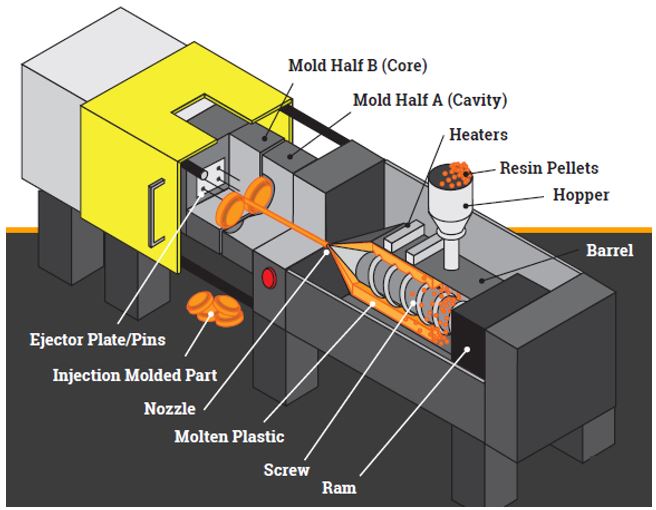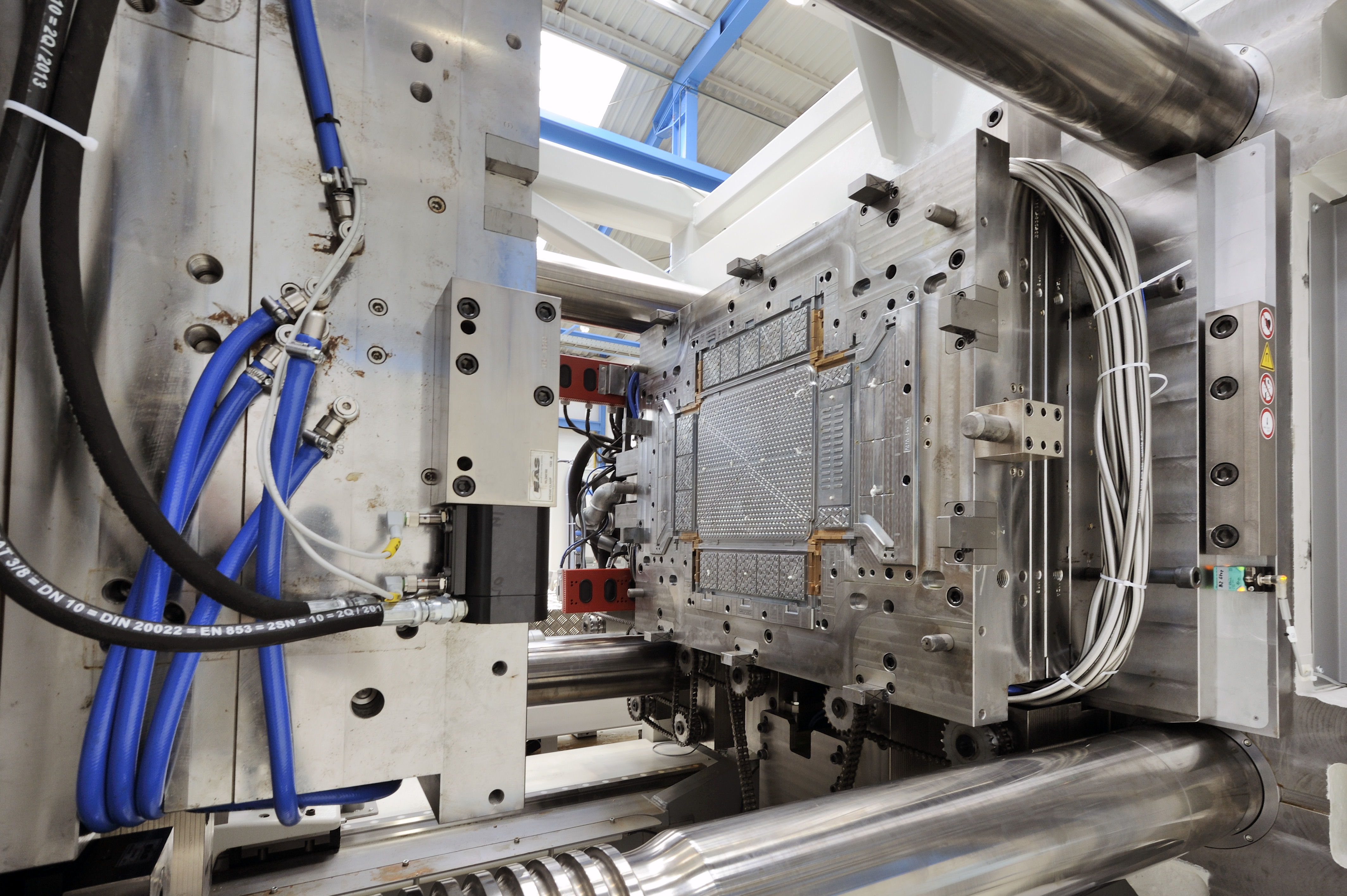Comprehending the Plastic Injection Molding Process for High-Quality Manufacturing
Comprehending the Plastic Injection Molding Process for High-Quality Manufacturing
Blog Article
Understanding the Basics of Plastic Injection Molding Processes
Plastic injection molding offers as a cornerstone of contemporary manufacturing, supplying a systematic approach to generating intricate components with precision. Discovering these necessary components can reveal just how even minor adjustments can lead to substantial improvements in manufacturing end results, elevating questions about the potential for advancement in this well-known procedure.
What Is Plastic Injection Molding?
Plastic shot molding is a commonly utilized production process that transforms thermosetting and polycarbonate materials right into exact and intricate shapes. This technique is favored for its ability to generate high volumes of identical get rid of phenomenal precision, making it a crucial method in various sectors, consisting of auto, durable goods, and clinical gadgets.
The procedure involves thawing the selected plastic product and infusing it right into a mold under high stress. The mold and mildew, designed to the specs of the desired component, permits the liquified plastic to take form as it solidifies and cools. Once the product has actually set, the mold and mildew is opened up, and the ended up part is ejected.
Plastic injection molding supplies numerous advantages, consisting of minimized waste, uniformity in manufacturing, and the capability to incorporate intricate designs that may be challenging with other manufacturing approaches. Additionally, it sustains a wide variety of products, each providing special properties that can be customized for particular applications. As markets remain to introduce, plastic shot molding stays at the center, enabling the growth of advanced products that satisfy evolving consumer needs.
The Shot Molding Process
The injection molding procedure is a sophisticated strategy that involves numerous vital phases to generate premium plastic parts. Plastic pellets are fed right into a heated barrel where they are thawed into a thick liquid. This molten plastic is after that infused under high stress into a precision-engineered mold and mildew, which shapes the product right into the preferred form.
As soon as the mold and mildew is filled up, the plastic is enabled to solidify and cool down, taking the shape of the mold and mildew dental caries. Cooling time is critical, as it affects the cycle time and the final properties of the molded part. After sufficient cooling, the mold opens, and the ended up element is expelled using ejector pins.

Materials Utilized in Shot Molding
Various products can be utilized in the injection molding process, each offering distinct residential or commercial properties that satisfy certain applications. The most generally utilized materials include thermoplastics, thermosetting plastics, and elastomers.

Thermosetting plastics, like epoxy and phenolic materials, undertake a chemical change throughout the treating process, causing an inflexible, inflexible structure. These products are excellent for applications needing explanation high warm resistance and structural integrity, commonly made use of in automotive components and electric insulators.
Elastomers, consisting of silicone and rubber-based products, supply adaptability and resilience. Their special homes make them suitable for applications that demand elasticity, such as seals and gaskets.
In addition, specialty materials like bio-based plastics and composites are getting grip for their ecological advantages and boosted efficiency characteristics, widening the extent of shot molding applications in numerous sectors. Understanding the properties of these materials is vital for choosing the appropriate type for specific projects.
Advantages of Injection Molding
Injection molding stands out as a highly efficient production process that provides various advantages for generating complicated get rid of accuracy. Among the most significant benefits is the capacity to develop complex designs that would be difficult or difficult to accomplish with other techniques (Plastic Injection Molding). about his The procedure enables for tight resistances and comprehensive functions, making certain premium elements
Additionally, shot molding is understood for its quick manufacturing abilities, making it an excellent option for high-volume manufacturing. As soon as the mold and mildew is created, parts can be created quickly, lowering lead times and boosting general productivity. This performance not only lowers manufacturing expenses but likewise supplies an one-upmanship in the market.
The adaptability of materials used in injection molding additionally enhances its charm. A large range of thermoplastics and thermosetting polymers can be used, enabling manufacturers to pick materials that finest meet their certain demands, consisting of versatility, toughness, and warmth resistance.
In addition, the procedure reduces waste, as excess material can usually be recycled and recycled. This sustainability aspect adds to a minimized environmental effect, making shot molding a responsible manufacturing option. On the whole, the advantages of injection molding make it a favored approach for many markets.
Aspects Influencing Item High Quality
While many elements can influence product quality in shot molding, recognizing these components is essential for accomplishing optimum outcomes. Trick facets include material choice, processing specifications, and mold design.
Product option plays a vital role, as different polymers display distinct homes that impact flowability, toughness, and thermal stability. Insufficient product option can cause problems such as warping or incomplete dental filling.
Handling parameters, consisting of temperature level, cycle, and pressure time, need to be thoroughly managed. Variants in these settings can cause incongruities partially measurements and surface area coating. For example, exceedingly high temperatures might create deterioration of the polymer, while poor stress can cause brief shots.
Mold and mildew design is equally important, website here as it establishes the flow of the molten plastic and the cooling procedure. Poorly made molds might bring about uneven air conditioning rates, leading to dimensional mistakes and residual stresses.

Conclusion
Finally, plastic injection molding functions as an essential production process that makes it possible for the reliable manufacturing of premium components. Mastery of the injection molding procedure, including the understanding of products and the impact of numerous factors on product quality, is crucial for accomplishing optimum outcomes. The benefits of this approach, such as cost-effectiveness and layout adaptability, additional highlight its importance across several markets, solidifying its condition as a favored selection for high-volume manufacturing.
Plastic injection molding offers as a cornerstone of contemporary manufacturing, offering a methodical strategy to producing complicated parts with precision.Plastic injection molding supplies numerous advantages, consisting of minimized waste, consistency in manufacturing, and the capability to include elaborate styles that might be challenging with other manufacturing methods (Plastic Injection Molding). As markets continue to innovate, plastic shot molding remains at the center, making it possible for the development of innovative items that satisfy progressing consumer needs
The injection molding process is an innovative strategy that involves a number of essential stages to generate high-grade plastic elements.In conclusion, plastic injection molding serves as an important manufacturing process that makes it possible for the effective manufacturing of high-quality elements.
Report this page